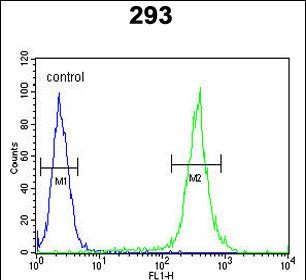UNC13B Antibody (Center)
Affinity Purified Rabbit Polyclonal Antibody (Pab)
- SPECIFICATION
- CITATIONS: 1
- PROTOCOLS
- BACKGROUND

Application
| FC, WB, E |
|---|---|
| Primary Accession | O14795 |
| Other Accession | Q9Z1N9 |
| Reactivity | Human |
| Predicted | Mouse |
| Host | Rabbit |
| Clonality | Polyclonal |
| Isotype | Rabbit IgG |
| Calculated MW | 180679 Da |
| Antigen Region | 1062-1091 aa |
| Gene ID | 10497 |
|---|---|
| Other Names | Protein unc-13 homolog B, Munc13-2, munc13, UNC13B, UNC13 |
| Target/Specificity | This UNC13B antibody is generated from rabbits immunized with a KLH conjugated synthetic peptide between 1062-1091 amino acids from the Central region of human UNC13B. |
| Dilution | FC~~1:10~50 WB~~1:1000 E~~Use at an assay dependent concentration. |
| Format | Purified polyclonal antibody supplied in PBS with 0.09% (W/V) sodium azide. This antibody is purified through a protein A column, followed by peptide affinity purification. |
| Storage | Maintain refrigerated at 2-8°C for up to 2 weeks. For long term storage store at -20°C in small aliquots to prevent freeze-thaw cycles. |
| Precautions | UNC13B Antibody (Center) is for research use only and not for use in diagnostic or therapeutic procedures. |
| Name | UNC13B (HGNC:12566) |
|---|---|
| Synonyms | UNC13 |
| Function | Plays a role in vesicle maturation during exocytosis as a target of the diacylglycerol second messenger pathway. Is involved in neurotransmitter release by acting in synaptic vesicle priming prior to vesicle fusion and participates in the activity-depending refilling of readily releasable vesicle pool (RRP) (By similarity). Essential for synaptic vesicle maturation in a subset of excitatory/glutamatergic but not inhibitory/GABA-mediated synapses (By similarity). In collaboration with UNC13A, facilitates neuronal dense core vesicles fusion as well as controls the location and efficiency of their synaptic release (By similarity). |
| Cellular Location | Cytoplasm. Membrane; Peripheral membrane protein. Cell membrane Synapse. Note=Localized to synapses. Translocated to the plasma membrane in response to phorbol ester binding (By similarity) |
| Tissue Location | Expressed in kidney cortical epithelial cells and brain. |

Provided below are standard protocols that you may find useful for product applications.
Background
UNC13B plays a role in vesicle maturation during exocytosis as a target of the diacylglycerol second messenger pathway. It is involved in neurotransmitter release by acting in synaptic vesicle priming prior to vesicle fusion and participates in the activity-depending refilling of readily releasable vesicle pool (RRP). It is essential for synaptic vesicle maturation in a subset of excitatory/glutamatergic but not inhibitory/GABA-mediated synapses (By similarity).
References
Sjoeblom T., et.al., Science 314:268-274(2006).
Yu L.-R., Zhu Z., et.al., J. Proteome Res. 6:4150-4162(2007).
If you have used an Abcepta product and would like to share how it has performed, please click on the "Submit Review" button and provide the requested information. Our staff will examine and post your review and contact you if needed.
If you have any additional inquiries please email technical services at tech@abcepta.com.














 Foundational characteristics of cancer include proliferation, angiogenesis, migration, evasion of apoptosis, and cellular immortality. Find key markers for these cellular processes and antibodies to detect them.
Foundational characteristics of cancer include proliferation, angiogenesis, migration, evasion of apoptosis, and cellular immortality. Find key markers for these cellular processes and antibodies to detect them. The SUMOplot™ Analysis Program predicts and scores sumoylation sites in your protein. SUMOylation is a post-translational modification involved in various cellular processes, such as nuclear-cytosolic transport, transcriptional regulation, apoptosis, protein stability, response to stress, and progression through the cell cycle.
The SUMOplot™ Analysis Program predicts and scores sumoylation sites in your protein. SUMOylation is a post-translational modification involved in various cellular processes, such as nuclear-cytosolic transport, transcriptional regulation, apoptosis, protein stability, response to stress, and progression through the cell cycle. The Autophagy Receptor Motif Plotter predicts and scores autophagy receptor binding sites in your protein. Identifying proteins connected to this pathway is critical to understanding the role of autophagy in physiological as well as pathological processes such as development, differentiation, neurodegenerative diseases, stress, infection, and cancer.
The Autophagy Receptor Motif Plotter predicts and scores autophagy receptor binding sites in your protein. Identifying proteins connected to this pathway is critical to understanding the role of autophagy in physiological as well as pathological processes such as development, differentiation, neurodegenerative diseases, stress, infection, and cancer.


